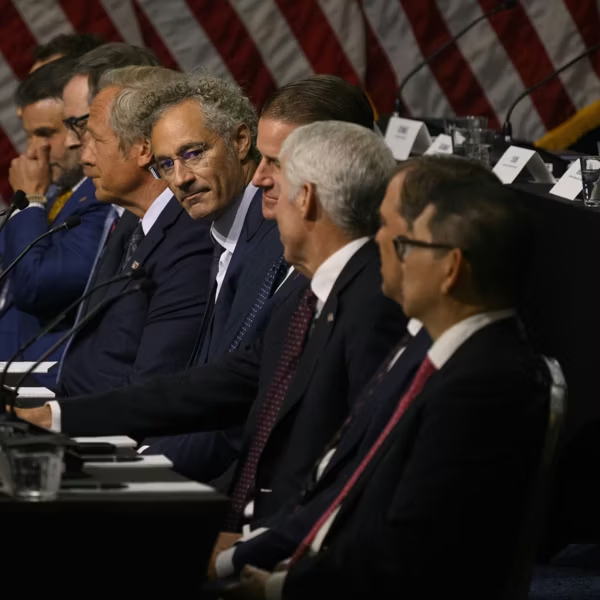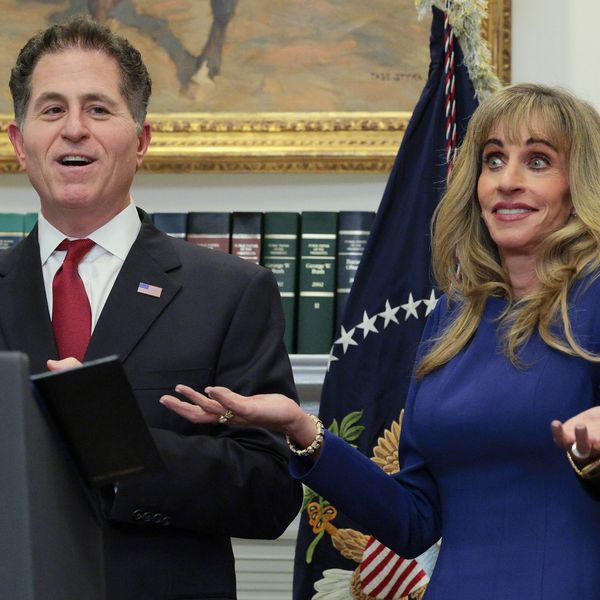
A volunteer attends a Feeding America event at Los Angeles Regional Food Bank on April 5, 2024 in Los Angeles.
Simple Charity Reforms Could Unlock Hundreds of Billions for Nonprofit Sector
An estimated $1.7 trillion in donations, ostensibly earmarked for philanthropy, are currently languishing in private foundations and donor-advised funds—while charities like Feeding America and Habitat for Humanity are under-resourced.
Thanks to outdated charity tax laws, the U.S. is missing out on hundreds of billions of dollars that could flow toward housing and food security, health research, education, advocacy, and other crucial nonprofit efforts aimed at uplifting the common good—but simple reforms could unlock some of the extreme wealth that is currently "warehoused" in private foundations and donor-advised funds.
This is according to a new Institute for Policy Studies analysis that shows charitable groups currently hold an estimated $1.7 trillion in donations that are "ostensibly earmarked for philanthropy," but are able to "languish in go-between funds" while working charities remain under-resourced.
The foundations and donor-advised funds (DAFs) are able to collect tax breaks while sitting on billions of dollars thanks to provisions in the Tax Reform Act of 1969 that haven't been updated in decades, wrote IPS associate fellow Helen Flannery and associate director of charity reform initiatives Bella DeVaan at Inequality.org, a project of the organization.
"Initially, in the Tax Reform Act of 1969, private foundations were mandated to give away 6 percent of their wealth or the annual net growth from their investments: Whichever was higher," wrote Flannery and DeVaan. "Foundations' tax benefits wouldn't provide license for funds to just grow forever and ever, and they were to be consistently responsive to shifting economic reality. A decade of revisions to payout requirements reflected those principles and eventually created our flat 5% mandate. But that 5% is overdue for re-evaluation, and our elected representatives have fallen asleep at the wheel."
"It's worth imagining a future in which billions more flow towards life-saving medical cures, food security, housing access, and environmental protection through organizations that are already woven into our social fabric."
While the nation's largest foundations give charitable donations at a rate of about 5%, "their gains in the market have averaged 9% over the last five years," they explained.
In other words, said Flannery and DeVaan, the funds "are growing faster than the rate at which they give" while donations to working charities like Habitat for Humanity, United Way, and Feeding America fall behind.
The wealth of DAFs has skyrocketed by 411% in the last decade, with the funds stockpiling an estimated $230 billion in assets in 2023.
IPS noted that billions of dollars in DAF gifts have been directed as dark money contributions—whose donors "might well have second thoughts" if tax laws were reformed to require both boosted payouts and more transparency.
In its policy brief, IPS proposes reforms that would:
- Increase the minimum payout rate requirement to 10% for foundations with assets of $50 million or more, and increase it to 7% for all other foundations;
- Exclude private foundation overhead expenses above 1% of assets from counting towards payout;
- Exclude grants from private foundations to DAFs from counting towards payout;
- Require DAFs to pay out funds within five years of receipt (and provide individual account-level transparency);
- Exclude grants from DAFs to other DAFs from counting toward payout; and
- Generate excise tax revenue from intermediaries that don't meet the new requirements.
"It's worth imagining a future in which billions more flow towards life-saving medical cures, food security, housing access, and environmental protection through organizations that are already woven into our social fabric," wrote Flannery and DeVaan, "or organizations that could and should be with strengthened access to funding."
IPS released the analysis as legislators prepare to overhaul the tax code in 2025.
"We're hopeful that this can be a watershed moment for charity reform akin to 1969," wrote Flannery and DeVaan, along with IPS program director Chuck Collins.
An Urgent Message From Our Co-Founder
Dear Common Dreams reader, The U.S. is on a fast track to authoritarianism like nothing I've ever seen. Meanwhile, corporate news outlets are utterly capitulating to Trump, twisting their coverage to avoid drawing his ire while lining up to stuff cash in his pockets. That's why I believe that Common Dreams is doing the best and most consequential reporting that we've ever done. Our small but mighty team is a progressive reporting powerhouse, covering the news every day that the corporate media never will. Our mission has always been simple: To inform. To inspire. And to ignite change for the common good. Now here's the key piece that I want all our readers to understand: None of this would be possible without your financial support. That's not just some fundraising cliche. It's the absolute and literal truth. We don't accept corporate advertising and never will. We don't have a paywall because we don't think people should be blocked from critical news based on their ability to pay. Everything we do is funded by the donations of readers like you. Will you donate now to help power the nonprofit, independent reporting of Common Dreams? Thank you for being a vital member of our community. Together, we can keep independent journalism alive when it’s needed most. - Craig Brown, Co-founder |
Thanks to outdated charity tax laws, the U.S. is missing out on hundreds of billions of dollars that could flow toward housing and food security, health research, education, advocacy, and other crucial nonprofit efforts aimed at uplifting the common good—but simple reforms could unlock some of the extreme wealth that is currently "warehoused" in private foundations and donor-advised funds.
This is according to a new Institute for Policy Studies analysis that shows charitable groups currently hold an estimated $1.7 trillion in donations that are "ostensibly earmarked for philanthropy," but are able to "languish in go-between funds" while working charities remain under-resourced.
The foundations and donor-advised funds (DAFs) are able to collect tax breaks while sitting on billions of dollars thanks to provisions in the Tax Reform Act of 1969 that haven't been updated in decades, wrote IPS associate fellow Helen Flannery and associate director of charity reform initiatives Bella DeVaan at Inequality.org, a project of the organization.
"Initially, in the Tax Reform Act of 1969, private foundations were mandated to give away 6 percent of their wealth or the annual net growth from their investments: Whichever was higher," wrote Flannery and DeVaan. "Foundations' tax benefits wouldn't provide license for funds to just grow forever and ever, and they were to be consistently responsive to shifting economic reality. A decade of revisions to payout requirements reflected those principles and eventually created our flat 5% mandate. But that 5% is overdue for re-evaluation, and our elected representatives have fallen asleep at the wheel."
"It's worth imagining a future in which billions more flow towards life-saving medical cures, food security, housing access, and environmental protection through organizations that are already woven into our social fabric."
While the nation's largest foundations give charitable donations at a rate of about 5%, "their gains in the market have averaged 9% over the last five years," they explained.
In other words, said Flannery and DeVaan, the funds "are growing faster than the rate at which they give" while donations to working charities like Habitat for Humanity, United Way, and Feeding America fall behind.
The wealth of DAFs has skyrocketed by 411% in the last decade, with the funds stockpiling an estimated $230 billion in assets in 2023.
IPS noted that billions of dollars in DAF gifts have been directed as dark money contributions—whose donors "might well have second thoughts" if tax laws were reformed to require both boosted payouts and more transparency.
In its policy brief, IPS proposes reforms that would:
- Increase the minimum payout rate requirement to 10% for foundations with assets of $50 million or more, and increase it to 7% for all other foundations;
- Exclude private foundation overhead expenses above 1% of assets from counting towards payout;
- Exclude grants from private foundations to DAFs from counting towards payout;
- Require DAFs to pay out funds within five years of receipt (and provide individual account-level transparency);
- Exclude grants from DAFs to other DAFs from counting toward payout; and
- Generate excise tax revenue from intermediaries that don't meet the new requirements.
"It's worth imagining a future in which billions more flow towards life-saving medical cures, food security, housing access, and environmental protection through organizations that are already woven into our social fabric," wrote Flannery and DeVaan, "or organizations that could and should be with strengthened access to funding."
IPS released the analysis as legislators prepare to overhaul the tax code in 2025.
"We're hopeful that this can be a watershed moment for charity reform akin to 1969," wrote Flannery and DeVaan, along with IPS program director Chuck Collins.
- Patronizing Evil: The Nonprofit Sector Perpetuates the Worst Legacies of Capitalism ›
- Secret IRS Files Reveal Super-Low Tax Rates of Super-Wealthy Americans ›
- New Bill Would Prevent Billionaires From Donating to Dark Money Groups Tax-Free ›
- Opinion | It's Time for Philanthropists to Get Into Climate Emergency Mode | Common Dreams ›
- For Wall Street-Fueled Philanthropy Industry, Every Day Is Giving Tuesday | Common Dreams ›
Thanks to outdated charity tax laws, the U.S. is missing out on hundreds of billions of dollars that could flow toward housing and food security, health research, education, advocacy, and other crucial nonprofit efforts aimed at uplifting the common good—but simple reforms could unlock some of the extreme wealth that is currently "warehoused" in private foundations and donor-advised funds.
This is according to a new Institute for Policy Studies analysis that shows charitable groups currently hold an estimated $1.7 trillion in donations that are "ostensibly earmarked for philanthropy," but are able to "languish in go-between funds" while working charities remain under-resourced.
The foundations and donor-advised funds (DAFs) are able to collect tax breaks while sitting on billions of dollars thanks to provisions in the Tax Reform Act of 1969 that haven't been updated in decades, wrote IPS associate fellow Helen Flannery and associate director of charity reform initiatives Bella DeVaan at Inequality.org, a project of the organization.
"Initially, in the Tax Reform Act of 1969, private foundations were mandated to give away 6 percent of their wealth or the annual net growth from their investments: Whichever was higher," wrote Flannery and DeVaan. "Foundations' tax benefits wouldn't provide license for funds to just grow forever and ever, and they were to be consistently responsive to shifting economic reality. A decade of revisions to payout requirements reflected those principles and eventually created our flat 5% mandate. But that 5% is overdue for re-evaluation, and our elected representatives have fallen asleep at the wheel."
"It's worth imagining a future in which billions more flow towards life-saving medical cures, food security, housing access, and environmental protection through organizations that are already woven into our social fabric."
While the nation's largest foundations give charitable donations at a rate of about 5%, "their gains in the market have averaged 9% over the last five years," they explained.
In other words, said Flannery and DeVaan, the funds "are growing faster than the rate at which they give" while donations to working charities like Habitat for Humanity, United Way, and Feeding America fall behind.
The wealth of DAFs has skyrocketed by 411% in the last decade, with the funds stockpiling an estimated $230 billion in assets in 2023.
IPS noted that billions of dollars in DAF gifts have been directed as dark money contributions—whose donors "might well have second thoughts" if tax laws were reformed to require both boosted payouts and more transparency.
In its policy brief, IPS proposes reforms that would:
- Increase the minimum payout rate requirement to 10% for foundations with assets of $50 million or more, and increase it to 7% for all other foundations;
- Exclude private foundation overhead expenses above 1% of assets from counting towards payout;
- Exclude grants from private foundations to DAFs from counting towards payout;
- Require DAFs to pay out funds within five years of receipt (and provide individual account-level transparency);
- Exclude grants from DAFs to other DAFs from counting toward payout; and
- Generate excise tax revenue from intermediaries that don't meet the new requirements.
"It's worth imagining a future in which billions more flow towards life-saving medical cures, food security, housing access, and environmental protection through organizations that are already woven into our social fabric," wrote Flannery and DeVaan, "or organizations that could and should be with strengthened access to funding."
IPS released the analysis as legislators prepare to overhaul the tax code in 2025.
"We're hopeful that this can be a watershed moment for charity reform akin to 1969," wrote Flannery and DeVaan, along with IPS program director Chuck Collins.
- Patronizing Evil: The Nonprofit Sector Perpetuates the Worst Legacies of Capitalism ›
- Secret IRS Files Reveal Super-Low Tax Rates of Super-Wealthy Americans ›
- New Bill Would Prevent Billionaires From Donating to Dark Money Groups Tax-Free ›
- Opinion | It's Time for Philanthropists to Get Into Climate Emergency Mode | Common Dreams ›
- For Wall Street-Fueled Philanthropy Industry, Every Day Is Giving Tuesday | Common Dreams ›

